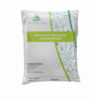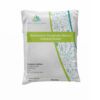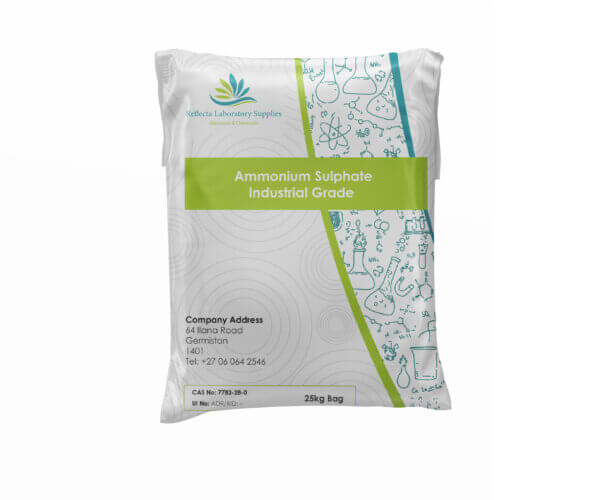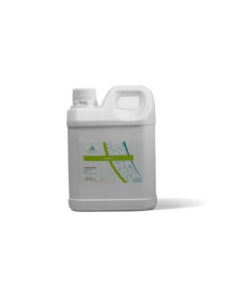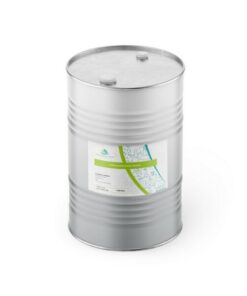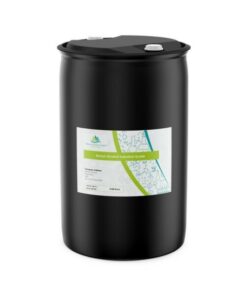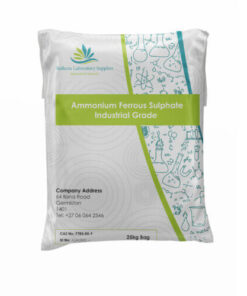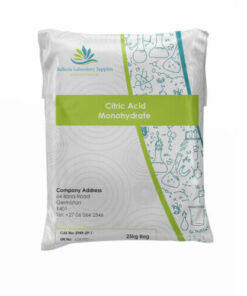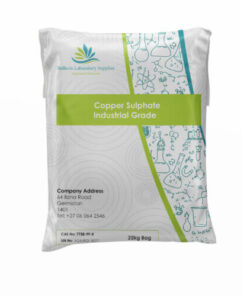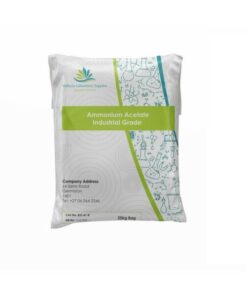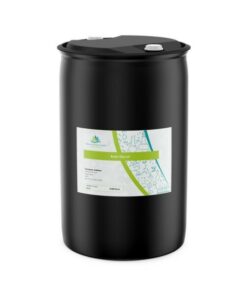Ammonium Sulphate Industrial Grade – 25kg
R2,185.79 Ex VAT
Ammonium Sulphate Industrial Grade – 25kg
**Ammonium Sulphate Industrial Grade – Identification of Product** Chemical Code: CHE-A50 Chemical Name: Ammonium Sulphate Chemical Grade: Industrial Grade Chemical Formula: H₈N₂O₄S Chemical Weight: 132.14 g/mol CAS No: 7783-20-2 Chemical Synonyms: No Data Available **Ammonium Sulphate Industrial Grade – Hazards Identification** REACH No: No Data Available Signal Word: Warning Supplemental Hazard Information: Not a hazardous substance or mixture according to Regulation (EC) No. 1272/2008. Additional Hazard Information: This substance/mixture contains no components considered to be either persistent, bioaccumulative and toxic (PBT), or very persistent and very bioaccumulative (vPvB) at levels of 0.1% or higher **Ammonium Sulphate Industrial Grade – Composition of Chemical** Chemical Formula: H₈N₂O₄S EC No 1272/2008: No Data Available **Ammonium Sulphate Industrial Grade – First Aid Measures** General Advice: Consult a physician. Show this safety data sheet to the doctor in attendance. If: Inhaled: If breathed in, move person into fresh air. If not breathing, give artificial respiration. Consult a physician. If: Skin Contact: Wash off with soap and plenty of water. Consult a physician. If: Eye Contac: Flush eyes with water as a precaution. If: Swallowed: Never give anything by mouth to an unconscious person. Rinse mouth with water. Consult a physician. Important Symptoms: The most important known symptoms and effects are described in the labeling section. Immediate Medical Attention: No Data Available **Firefighting Measures** Extinguishing Media: Use extinguishing measures that are appropriate to local circumstances and the surrounding environment. Hazards Arising: Nitrogen Oxides (NOx), Sulphur Oxides Advice for Firefighters: Wear self-contained breathing apparatus for firefighting if necessary. Info for Firefighting: No Data Available **Ammonium Sulphate Industrial Grade – Accidental Release Measures** Personal Precautions: Use personal protective equipment. Avoid dust formation. Avoid breathing vapours, mist or gas. Ensure adequate ventilation. Avoid breathing dust. Enviromental Precautions: Prevent further leakage or spillage if safe to do so. Do not let product enter drains. Discharge into the environment must be avoided. Method for Containment: Pick up and arrange disposal without creating dust. Sweep up and shovel. Keep in suitable, closed containers for disposal. **Ammonium Sulphate Industrial Grade – Handling and Storage** Personal Precautions: Avoid formation of dust and aerosols. Provide appropriate exhaust ventilation at places where dust is formed. Enviromental Precautions: Store in cool place. Keep container tightly closed in a dry and well-ventilated place. **Exposure Controls | Personal Protection** Derived No Effect Level (DNEL) Workers | Application Area | Exposure Routes | Health Effect | Value No Data Available Consumers | Application Area | Exposure Routes | Health Effect | Value No Data Available Predicted No Effect Concentration (PNEC) No Data Available Engineering Controls: Handle in accordance with good industrial hygiene and safety practice. Wash hands before breaks and at the end of workday. Eye/Face Protection: Use equipment for eye protection tested and approved under appropriate government standards such as NIOSH (US) or EN 166 (EU). Skin Protection: Handle with gloves. Gloves must be inspected prior to use. Use proper glove removal technique (without touching gloves outer surface) to avoid skin contact with this product. Dispose of contaminated gloves after use in accordance with applicable laws and good laboratory practices. Wash and dry hands. The selected protective gloves have to satisfy the specifications of EU Directive 89/686/EEC and the standard EN 374 derived from it. Full contact: Material: Nitrile rubber Minimum layer thickness: 0,11 mm Break through time: 480 min Material tested: Dermatril® Splash protection: Material: Nitrile rubber Minimum layer thickness: 0,11 mm Break through time: > 30 min Material tested: Dermatril® Data source: KCL GmbH, D-36124, Test method: EN 374 If used in solution, or mixed with other substances, and under conditions which differ from EN 374, contact the supplier of the CE approved gloves. This recommendation is advisory only and must be evaluated by an Industrial Hygienist familiar with the specific situation of anticipated use by our customers. It should not be construed as offering an approval for any specific use scenario. Body Protection: Choose body protection in relation to its type, to the concentration and amount of dangerous substances, and to the specific work-place. The type of protective equipment must be selected according to the concentration and amount of the dangerous substance at the specific workplace. Respiratory Protection: Respiratory protection is not required. Where protection from nuisance levels of dusts are desired, use type N95 (US) or type P1 (EN 143) dust masks. Use respirators and components tested and approved under appropriate government standards such as NIOSH (US) or CEN (EU). **Physical and Chemical Properties** Appearance: Brownish Grey to White crystals Odour: No Data Available Odour Threshold: No Data Available pH: 5.0 – 6.0 at 132 g/l at 25 °C Melting Point: Melting point/range: > 280 °C – dec. Boiling Point: No Data Available Flash Point: No Data Available Evaporation: No Data Available Flammability: No Data Available Upper/Lower Flammability or Explosive Limits: No Data Available Vapour pressure: No Data Available Vapour density: No Data Available Relative density: 1.77 g/cm3 at 25 °C Water solubility: 132 g/l at 20 °C – Completely Soluble Partition Coefficien: Log Pow: – 5.1 Auto-ignition Temperature: No Data Available Decomposition Temperature: No Data Available Viscosity: No Data Available Explosive properties: No Data Available Oxidizing properties: No Data Available Other Safety Info: No Data Available **Stability and Reactivity** Reactivity: No Data Available Chemical Stability: Stable under recommended storage conditions Possibility of hazardous reactions: No Data Available Conditions to Avoid: Avoid moisture Incompatible Materials: Strong oxidizing agents, Strong bases Hazardous Decomposition Products: Hazardous decomposition products formed under fire conditions – Nitrogen Oxides (NOx), Sulphur Oxides Other decomposition products – No Data Available **Toxicological Information** Acute Toxicity: LD50 Oral – Rat – 4.250 mg/kg (OECD Test Guideline 401) LD50 Dermal Dermal – Rat -> 2.000 mg/kg Skin Corrosion/Irritation: Skin – Rabbit Result: No skin irritation Serious Eye damage | Eye Irritation: Eyes – Rabbit Result: No eye irritation Cell Mutagenicity: No Data Available Carcinogenicity: IARC: No component of this product present at levels greater than or equal to 0.1% is identified as probable, possible or confirmed human carcinogen by IARC. Reproductive toxicity: No Data Available Specific Target Organ Toxicity – Single Exposure: No Data Available Specific Target Organ Toxicity – Repeated Exposure: No Data Available Aspiration Hazard: No Data Available **Ecological Information** Ecological Toxicity: Toxicity to fish: LC50 – Leuciscus idus (Golden orfe) -> 460 mg/l – 96 h Toxicity to daphnia and other aquatic invertebrates: LC50 – Daphnia (water flea) – 129 mg/l – 48 h Ecological Persistence and degradability: The methods for determining biodegradability are not applicable to inorganic substances. Bioaccumulative Potential: No Data Available Mobility in Soil: No Data Available Results of PBT and vPvB Assessment: This substance/mixture contains no components considered to be either persistent, bioaccumulative and toxic (PBT), or very persistent and very bioaccumulative (vPvB) at levels of 0.1% or higher. Other Adverse Effect: Harmful to aquatic life **Disposal Considerations** Waste Treatment Methods: Product Offer surplus and non-recyclable solutions to a licensed disposal company. Contact a licensed professional waste disposal service to dispose of this material. **Contaminated packaging** Dispose of as unused product. Transport Information UN Number: ADR/RID: – IMDG: – IATA: – UN Shipping Hazard: ADR/RID: Not dangerous goods IMDG: Not dangerous goods IATA: Not dangerous goods Transport Hazard Class: ADR/RID: – IMDG: – IATA: – Packaging Group: ADR/RID: – IMDG: – IATA: – Enviromental Hazards: ADR/RID: no IMDG Marine pollutant: no IATA: no Special Precautions: No Data Available Regulatory Information Safety, Health and environmental regulations: This safety datasheet complies with the requirements of Regulation (EC) No. 1907/2006. International Chemical Weapons Convention (CWC) Schedules of Toxic Chemicals and Precursors : Neither banned nor restricted Restrictions on the marketing and use of certain dangerous substances and preparations: Neither banned nor restricted Regulation (EC) No 649/2012 of the European Parliament and the Council concerning the export and import of dangerous chemicals : Neither banned nor restricted Candidate List of Substances of Very High Concern for Authorisation: Neither banned nor restricted Chemical Safety Assessment: For this product a chemical safety assessment was not carried out. Additional Info: RTECS: BS4500000 To the best of our knowledge, the chemical, physical, and toxicological properties have not been thoroughly investigated.
Disclaimer: The information stated above is considered to be correct, but does not claim to be inclusive and shall only be used as a guideline. The information provided by this document is confirmed by our continuous updating of knowledge and adheres to the products appropriate safety precautions. It does not represent any guarantee of the product’s properties. RLS Chemicals and its Associates shall not be held accountable for any damage’s consequent of handling the above product.
• Chemical Code: CHE-A50
• Chemical Name: Ammonium Sulphate
• Chemical Grade: Industrial Grade
• Chemical Formula: H₈N₂O₄S
• Chemical Weight: 132.14 g/mol
• CAS No: 7783-20-2
• Chemical Synonyms: No Data Available
• Appearance: Brownish Grey to White crystals
• pH: 5.0 – 6.0 at 132 g/l at 25 °C
• Melting Point: > 280 °C – dec.
• Relative density: 1.77 g/cm3 at 25 °C
• Water solubility: 132 g/l at 20 °C – Completely Soluble
• Partition Coefficient: Log Pow: – 5.1
• Chemical Code: CHE-A50
• Chemical Name: Ammonium Sulphate
• Chemical Grade: Industrial Grade
• Chemical Formula: H₈N₂O₄S
• Chemical Weight: 132.14 g/mol
• CAS No: 7783-20-2
• Appearance: Brownish Grey to White crystals
• pH: 5.0 – 6.0 at 132 g/l at 25 °C
• Melting Point: > 280 °C – dec.
• Relative density: 1.77 g/cm3 at 25 °C
• Water solubility: 132 g/l at 20 °C – Completely Soluble
• Partition Coefficient: Log Pow: – 5.1
Related products
Bulk Chemicals
Bulk Chemicals
Bulk Chemicals
Bulk Chemicals
Bulk Chemicals
Bulk Chemicals
Bulk Chemicals
Bulk Chemicals
